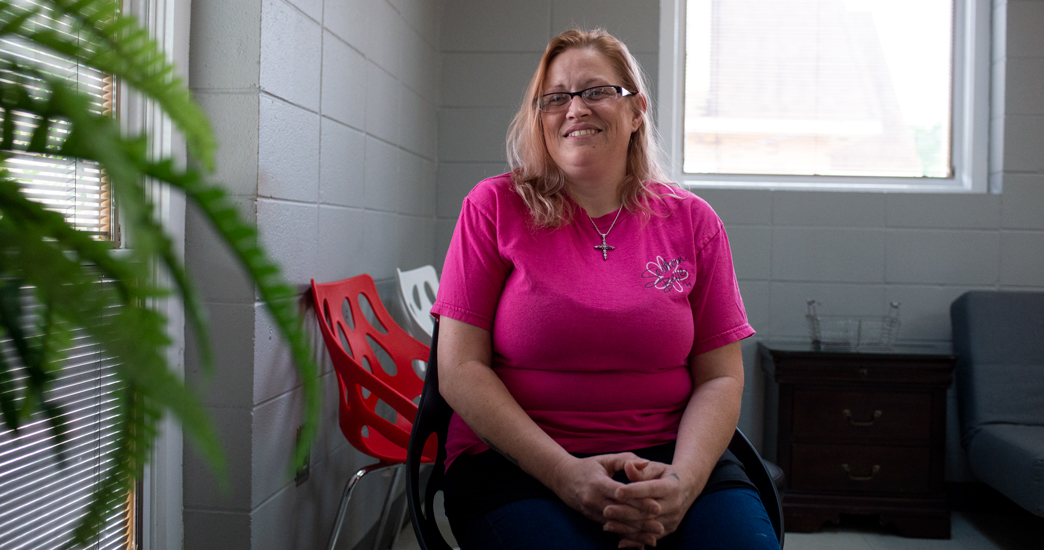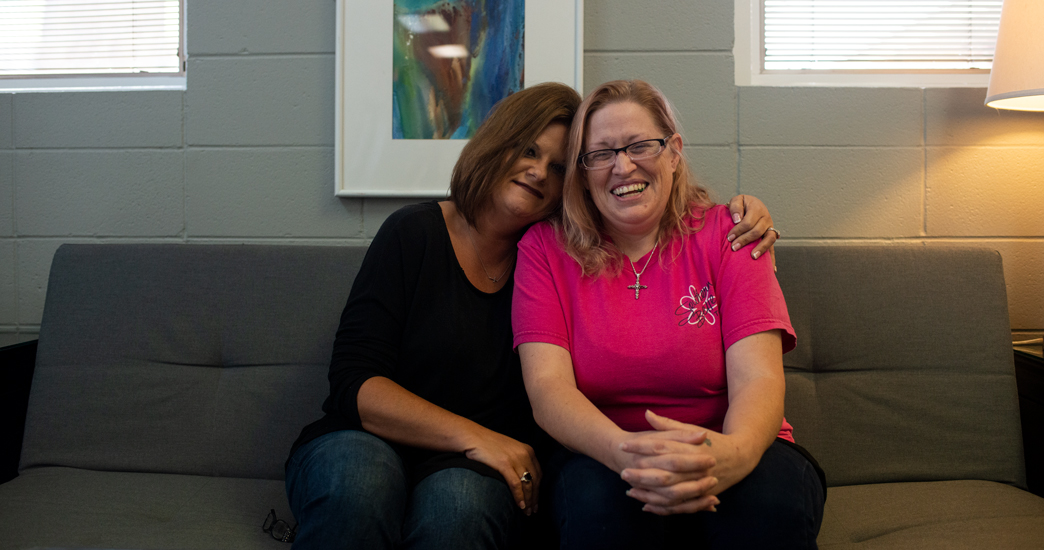Opportunity Costs: Community corrections program offers a roadmap for client success
Positive client outcomes indicate promising investment for fiscally sound prison alternatives, rather than prison construction.
Dixie Worrell believes it was her longing for a family – a loving husband, children and the emotional support that comes with it – that led her into the criminal justice system.
In 2017, she was charged with theft by deception when her then-boyfriend purchased a Cadillac Escalade with a stolen check. Worrell said she was only waiting in a car as the purchase was made, but she was charged anyway. The following year, she was arrested again after using stolen checks she said were provided by that same boyfriend, who sent her into a Walmart to buy several items, including a lawn mower battery.
“I was willing to do just about anything to keep him happy,” Worrell, now 40, said about the incident in Ozark, Alabama. “Using that check to go buy that damn lawn mower battery, I didn’t know the check was stolen. People are going to argue and say I did, but I didn’t.”
With a few other simple theft charges, Worrell could have found herself in the same position as the majority of Alabamians who are avoiding jail time only to face mounting debt through costly community corrections programs that charge excess fees on top court fines and restitution payments.
But Worrell was sentenced to one of the few community corrections programs in the state – Southeast Alabama Court Services in Dale County – that seek alternatives to passing down costly fees to their clients in order to help them get back on their feet.
The program, operated by executive director Cheryl Leatherwood, offers clients a range of services – like supervision and drug testing that normally costs hundreds of dollars – for $100 each month. But she is able to avoid other costs to participants through community support and donations that help offset other program costs.
The program’s $100 fee is still more than many can afford. But it is a far cry from the total amounts charged by other community correction programs across the state, which can cost clients hundreds of dollars each month depending on their sentences. For example, it costs $360 a month just for electronic monitoring in Lauderdale County in north Alabama. In Marshall County, people must pay in $200 assessment fees to simply start the program.
Worrell said the program, which is different from other programs in that it focuses heavily on rehabilitation and connecting clients with community resources instead of offering basic court-mandated supervision, provides her with a foundation for a better life. She even landed a job interview before she had completed a six-week rehab counseling program. What’s more, Worrell says the program provided her with the support and understanding she had sought for years.
“It feels like a family, and I don’t have one,” she said. “I’m grateful for this system … [Without it] I could still be a statistic in the jails.”
Worrell’s alternative could have resulted in a sentence in one of Alabama’s dangerous prisons.
In a state struggling with deadly, overcrowded prisons – and a community corrections system that, in many counties, seems focused primarily on collecting fees – the Southeast Alabama Court Services is an example of a program that provides an alternative to prison that uses all available community resources it can to avoid financially draining participants and derailing their rehabilitation.
“You have to realize that these are people no different than you are,” Leatherwood said. “You have to let them know beyond a shadow of a doubt that you are here to help them, not to hurt them. And that you will do everything you can to help them, not hurt them.”
When a person is sentenced to the program, that person is typically charged a $100 monthly fee. The cost is slightly higher than what is charged in other counties, but the flat fee covers supervision and any and all drug tests a client may take. Unlike programs elsewhere in the state, clients don’t encounter fee after fee that add to out-of-pocket costs.
Yet, despite a lack of financial investment from the state to support community corrections programs, in many cases, Leatherwood doesn’t require participant fees for the program at all.
“Half of our caseload doesn’t pay their fees because they can’t afford them,” she said. “I’m never going to send somebody to prison, or revoke them, or send them back to court because they don’t have the money. We work with them.”
The program also doesn’t have traditional GPS or ankle monitoring services that several counties use and can cost participants as much as $15 a day. Instead, Leatherwood uses a smartphone app that clients can download. Once the app is installed, photo check-ins and other methods are used to supervise and monitor the client. The app costs $11 a month, which is paid for by Leatherwood’s program.
Instead of mounting debt, clients encounter an array of resources. The program has relationships with hospitals and the Mary Hill Family Services Center, which is housed in the same building as the program’s main office. And, unlike other programs in the state, people are not sent to jail at the first sign of a failed drug test or sanctioned for not paying fees.
As executive director, Leatherwood recognizes that a majority of her program’s participants are facing issues with substance misuse, whether their specific charge is drug-related or not. When clients are referred to intensive outpatient treatment programs at SpectraCare (a nonprofit health care system that operates Dale County’s closest outpatient clinic) or into other treatment facilities across the state, she doesn’t worry about collecting community corrections program fees from those clients.
“I’m not going to lean on clients for fees to increase revenue,” Leatherwood said. Instead, the program – which provided services to about 70 people last year – operates on razor-thin margins by relying on local partnerships to keep its program funded and to retain dedicated employees. The program ended calendar year 2017 with $22,112 in leftover cash as a part of its net assets (accumulated funds and real estate) compared to the $117,241 in cash leftover for Walker County’s community corrections program for fiscal year 2018 (Oct. 1, 2017 to Sept. 8, 2018) according to tax documents. Both programs had roughly the same number of participants.
“I’m blessed to have a staff that’s willing to come early, stay late, to do whatever it takes to help [clients] be successful,” Leatherwood said.
Leatherwood began developing the program’s current structure after she took it over in 2012, when it was known as Dale County Court Services. She also faced a challenge: She inherited an office that was pervaded with scandal after the former director resigned following a state investigation that led to the arrest of an employee who allegedly stole funds from several participants in the program.
Since then, Leatherwood has negotiated with local judges and county officials to broaden the community corrections program into two neighboring counties, Pike and Coffee, slowly taking in more cases from each jurisdiction – cases that otherwise would have resulted in prison time for the defendants. Barbour County was also recently folded into the program’s coverage area. Last year, the program was officially renamed to Southeast Alabama Court Services to reflect the expansion.

Leatherwood’s work is also personal; she intimately understands her client’s struggles with substance misuse.
“My biggest qualification is speed,” she said of her own past substance use, which began with diet pills. In 1989, she went through treatment at a Bradford Health Services treatment center outside Montgomery. “That’s some of my solid foundation for this: I went through rehab, I went back to school, I got a bachelor’s in psych, in sociology and in biology, and then thought, ‘Good grief, if you’re going to stay in school forever, at least get a master’s.’ So, then I got a master’s in public affairs.”
Leatherwood isn’t the only person bringing such personal experience to Southeast Alabama Court Services. There’s also Lisa Lee, who has operated Barbour County’s community corrections program since 2015. Lee was recruited by Leatherwood, and Barbour County was folded into Southeast Alabama Court Services earlier this year.
When Lee was in her early 20s, she struggled with the use of prescription medication for anxiety and panic disorders. It’s an experience that allows her to see things from a client’s perspective.
“From where I have been to rehab, I often think it could be changed. They could be sitting there, seeing me,” she said of working with clients. “I always ask the question, in the back of my head, ‘Why is somebody in here? What did they not get?’ I treat them with respect. I don’t treat them as criminals. I treat them as if they are humans that made some very poor decisions.”
It’s this understanding and support that leads clients to cite these two women as a critical component of the program.
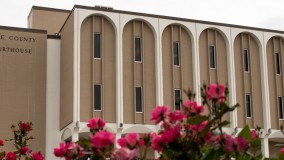
April Shelton entered the community corrections program in Dale County as a pre-trial diversion participant in July 2015. Shelton, now 34, was facing almost two dozen counts of identity theft across three counties to fund her habit of substance misuse.
She spent roughly seven months in jail before she was released into Leatherwood’s program as a pre-trial condition. She said jail was where she detoxed. While her cases were being decided in court, Shelton said she had to prove to Leatherwood she could successfully remain in community corrections. Otherwise, she said she could have faced 72 months in prison.
“I went to my trial in Coffee County and I had done so good, I mean all my random drug screens were negative,” she said. “I did all my classes. I was working. I was doing everything I could to show progress to Cheryl, and she talked to the judge and they agreed that I could stay in community corrections instead of going to prison.”
She was officially sentenced in April 2016 and spent the next two years under community supervision in Leatherwood’s program. She had a steady job as a waitress at a local barbecue restaurant until it closed in early 2017. Shortly after, she found out she was pregnant with her son and had trouble maintaining her employment.
Leatherwood remained supportive, didn’t require Shelton to pay program fees for her to remain in the program during her pregnancy and even helped her get into school at Enterprise State Community College that May.
“I had so many felonies,” Shelton said. “I said I don’t want to work in a restaurant when I have my baby, and I don’t want to work in a restaurant for the rest of my life. I told her that I really liked law and I wanted to be a paralegal. She was like, ‘You can do it. You can still be a paralegal.’ She kind of talked me into it.”
Shelton, whose son turned 2 in September, has graduated with an associate’s degree in paralegal studies. She was shopping around for jobs at different law firms when interviewed for this story. She said Leatherwood has helped with the paperwork to get her record expunged, but she still owes thousands of dollars in restitution on her cases that will need to be paid first. It will take some time to pay it off, she said, but Shelton praises the support she’s received.
“Cheryl’s program is awesome,” she said. “People are always like, ‘Oh, they just want to get your money and throw you in jail.’ But with Cheryl, I’ve seen it. They give people ample opportunities. She really has helped a lot of people.”

Marcus Youngblood, a Pike County resident who started the program in January, said that the constant contact is critical.
“I can show you texts on my phone where we actually talk every other day, and just having someone, you know, with that much hands-on [involvement] and [who] really cares – you want to do better, you want to thrive,” Youngblood said. “They have so much personal interaction with each individual. Not just with me, but I see it with everybody, every time I come down here.”
Youngblood, 51, has experienced Alabama’s criminal justice system before. In 2005, he was charged with trafficking methamphetamine and served a little over three years in prison. He received every certification and took every class the law allowed in prison, he said. He never received any disciplinary infractions. When he was released, he was fortunate enough to quickly find work, remaining out of trouble for almost a decade.
After Youngblood’s mother died in late 2016, he fell back into substance misuse as he struggled with the loss. By early 2017, he had been charged with a misdemeanor in Crenshaw County for harassing communication – a charge he said was filed by a man who was, at the time, the boyfriend of his ex-girlfriend.
The charge was eventually dismissed, but it sparked a search at his home. Police found a small, green glass bottle containing a scant amount of meth along with drug paraphernalia; he was charged with possession of a controlled substance.
Because Youngblood had a prior conviction, he could have ended up in prison again. But his attorney was able to set him up with Southeast Alabama Court Services. The attorney also wrote a motion asking the court to consider mitigating factors, including Youngblood’s participation in the program, when determining his sentence.
“Defendant has made substantial changes to his life and has become a productive member of society,” the motion said. It noted Youngblood had started a new business, Tree Huggers Logging, and planned to plant a community garden to provide food for the underserved.
Four months after he was sentenced to community corrections, Youngblood was participating in classes at Spectracare and attending Alcoholics Anonymous meetings. His business was busy. And he was working with Leatherwood and Lee to grow food in his garden for the family services center next door to the community corrections office.
“Prison did not … benefit me in one single way,” Youngblood said. “It wasn’t scary enough to keep me from ever doing it again. I mean, these programs are going to be the key.”
While Youngblood says prison wasn’t scary enough to keep him out, he has friends in prison who’ve told him the environment is much harsher than when he did his time almost 15 years ago. During a follow-up interview in April, he was shaken up by the news of a friend who’d recently tried to die by suicide in prison. “Really hit home on what I need to do with life,” he said in a text.
A recent U.S. Department of Justice report described horrific conditions in Alabama’s prisons, which are at 166 percent capacity. The report outlines high rates of homicide and sexual abuse. It also notes that Alabama Department of Corrections (ADOC) officials are “deliberately indifferent” to the risks prisoners face and lists immediate actions that are needed, including hiring more correctional officers and transferring prisoners to reduce the population.
“You know when you send somebody to a place that they would rather die, that’s not prison. That’s totally something different,” Youngblood said. “The only way the state of Alabama is ever going to get it to where it’s not overcrowded is to mass produce these [community corrections] programs, and the people they pick to run these programs, they’re just really going to have to do their homework.”
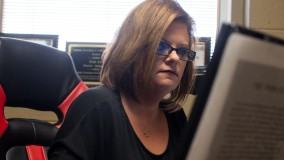
Leatherwood appears to have guided the Southeast Alabama Court Services to financial efficiency while serving its clients at lower costs. Like many community corrections organizations across the state, it’s a nonprofit 501(c)(3). According to its most recent Form 990, a public tax document that such organizations file to the IRS each year, the organization recorded $252,453 in revenue for calendar year 2017. Its total expenses were $205,876.
By comparison, the Marshall County Community Punishment and Corrections Authority, a community corrections program in north Alabama, recorded $2.6 million in revenue just from program services, according to its Form 990 for fiscal year 2016 (Oct. 1, 2016 to Sept. 30, 2017). About $1.5 million of that revenue came from the program’s work release participants. Total program service expenses for the Marshall County program were $1.6 million.
Despite a roughly 10-fold difference in revenue, the programs have about the same number of participants. In late December, Leatherwood said Southeast Alabama Court Services was currently supervising about 125 people. The Marshall County program, meanwhile, was supervising about 118 people in January, said its program director, Marcheta Shaw.
Efficient and effective community corrections programs could be a key to addressing Alabama’s prisons woes.
Alabama Gov. Kay Ivey is currently proposing the construction of three new prisons as a solution to prison overcrowding – at a tune of roughly $900 million.
Meanwhile, ADOC’s contract with Southeast Alabama Court Services, which serves multiple counties, costs only $77,436 for the last fiscal year.
Under state regulations, ADOC can reimburse such programs $10 a day for each person who is either a front-end or institutional diversion who meets the criteria. ADOC pays $15 a day for each individual who is deemed high-risk. The reimbursement period, however, only lasts two years, and the daily per diem rate hasn’t changed in over a decade. An increase would go a long way for programs such as Southeast Alabama Court Services and would cost the state far less than its heavy reliance on prisons.
Due to the funding formula, most community corrections programs rely heavily on charging fees to participants, many of whom struggle to keep up the payments while under supervision.
“If they would increase that per diem to even $15 a day for all of them and to $20 for those [high-risk] ones, then we could do more,” Leatherwood said. “Because we can only do so much. You know, we can get here early, and we can stay late, but I can’t have one of us out at 10 p.m. at night doing home visits. On top of that, we just don’t have the time.”
In 2018, according to its most recent annual report, ADOC spent an average of $60.34 per day for each of the approximately 20,600 people in prison. It spent less than 2 percent of its budget (about $9.3 million of a $14 million appropriation) on community corrections.
Given these figures, community corrections programs like the one Leatherwood operates seem to offer an attractive alternative to simply building more prisons – even if state funding for them is increased substantially to improve the services and lower the financial burden on participants in programs.
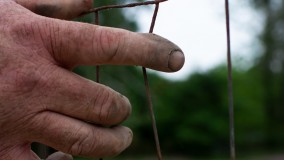
Back in Dale County, Southeast Alabama Court Services clients continue to navigate life in a state where far too many people find themselves behind bars or crushed by debt as they attempt to stay out of prison.
By May, Worrell had left her job at a fast-food restaurant because she knew she had to get away from the persistent drug use around her. By August, she’d finished her six-week rehab program at South Central Mental Health and was working full time at a hatchery. While things haven’t been easy – she still owes thousands in restitution for all of her cases – she says Leatherwood and Lee remain a constant source of support in her life.
“I feel like I can call Cheryl or Ms. Lisa and get that [support],” she said.
During a recent conversation, Leatherwood was happy to share another success story – this one of a client she helped receive a grant to enroll in school to get a commercial driver’s license. Months earlier, Leatherwood had written a $700 check to cover his rent. He was behind on his rent and in danger of losing his home at the same time he needed inpatient treatment.
Cutting a rent check for a client may have been an extraordinary step, but it helped provide him with more than just a roof over his head – it provided a foundation for a better future.
“We believe in investing in our clients, investing in their future, because they’re the future of our community,” Leatherwood said.
Return to the Opportunity Costs: Unequal Justice in Alabamas' Community Corrections Programs landing page.

